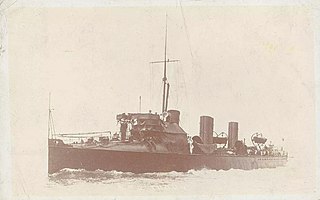HMS Electra was a Clydebank-built, three-funnelled, 30-knot destroyer ordered by the Royal Navy under the 1895–1896 Naval Estimates. She was the fourth ship to carry this name since it was introduced in 1806 for a 16-gun brig-sloop.

The B class as designated in 1913 was a heterogeneous group of torpedo boat destroyers (TBDs) built for the Royal Navy in the late 1890s. They were constructed to the individual designs of their builders to meet Admiralty specifications, the uniting feature being a specified top speed of 30 knots (56 km/h) and four funnels, although the funnel spacings differed between ships. All "30 knotter" vessels with four funnels were classified by the Admiralty as the B class in 1913 to provide some system to the naming of HM destroyers. At the same time all "30 knotter" vessels with three funnels were classified by the Admiralty as the C class and those with two funnels became the D class.

HMS Quail was a B-class torpedo boat destroyer of the British Royal Navy. She was launched by Laird Brothers, Birkenhead, on 24 September 1895. She served in home waters and the West Indies for several years, her robust structure proved by surviving at least one heavy collision. She served during the Great War, and was sold off after the hostilities end, on 23 July 1919. She gave her name to the four strong group of Quail-class destroyers.

HMS Sparrowhawk was a B-class torpedo boat destroyer of the Royal Navy. She was completed by Laird, Son & Company, Birkenhead, and was launched on 8 October 1895. She served on the China Station and was wrecked in the mouth of the Yangtze River in 1904. She was one of four Quail-class destroyers.

HMS Virago was a B-class torpedo boat destroyer of the British Royal Navy. She was completed by Laird Brothers, Birkenhead, in 1897. One of four Quail-class destroyers she served during the Great War and was sold off after hostilities ended.
HMS Orwell was a B-class torpedo boat destroyer of the British Royal Navy. She was built by Laird, Son & Company, and served from 1900 until 1920.

HMS Whiting was a Palmer three funnel, 30 knot destroyer ordered by the Royal Navy under the 1896 – 1897 Naval Estimates. She was the fifth ship to carry this name.

HMS Crane was a Palmer three-funnel, 30-knot destroyer ordered by the Royal Navy under the 1895–1896 Naval Estimates. She was the sixth ship to carry this name since it was introduced in 1590 for a 24-gun schooner in service until 1629.
HMS Otter was a Vickers three-funnel, 30-knot destroyer ordered by the Royal Navy under the 1895–1896 Naval Estimates. She was the fourth ship to carry this name since it was introduced in 1782 for a fire ship, sold in 1801.
HMS Sylvia was a Doxford three funnel - 30 knot destroyer ordered by the Royal Navy under the 1896 – 1897 Naval Estimates. She was the sixth ship to carry this name since it was introduced in 1806 for a cutter sold in 1816.

HMS Mermaid was a Hawthorn Leslie three-funnel, 30 knot destroyer ordered by the Royal Navy under the 1896 – 1897 Naval Estimates. She was launched in 1898, served during World War I and was sold for breaking in 1919.

HMS Greyhound was a Hawthorn Leslie three-funnel, 30 knot destroyer ordered by the Royal Navy under the 1898 – 1899 Naval Estimates.

HMS Desperate was a two funnel, 30-knot destroyer ordered by the Royal Navy under the 1894 – 1895 Naval Estimates. She was launched in 1896, served in Home waters and the Mediterranean before World War I. She was based in Portsmouth during the war and was sold for breaking in 1920.

HMS Mallard was a two funnel, 30-knot destroyer ordered by the Royal Navy under the 1894 – 1895 Naval Estimates. She served in Home waters both before and during the First World War, and was sold for breaking in 1920.

HMS Angler was a two-funnel, 30-knot destroyer ordered by the Royal Navy under the 1895 – 1896 Naval Estimates. She was the second ship to carry this name. She was launched in 1897, served at Chatham and Portsmouth and was sold for breaking in 1920.
HMS Vixen was a Vickers three funnel - 30 knot destroyer ordered by the Royal Navy under the 1895 – 1896 Naval Estimates. She was the fourth ship to carry this name since it was introduced in 1801 for an 18-gun brig sold 1815.
HMS Brazen was a Clydebank three-funnel, 30-knot destroyer ordered by the Royal Navy under the 1895-1896 Naval Estimates. She was the fifth ship to carry this name since it was introduced in 1781 for a 14-gun cutter, sold in 1799.

HMS Vulture was a Clydebank three funnel - 30 knot destroyer ordered by the Royal Navy under the 1895 – 1896 Naval Estimates. She was the fifth ship to carry this name since it was introduced in 1776 for a 14-gun sloop sold until 1802.

HMS Thorn was a Clydebank three funnel - 30 knot destroyer purchased by the Royal Navy under the 1899–1900 Naval Estimates. She was the second ship to carry this name since it was introduced in 1779 for a 16-gun sloop sold in 1816.
HMS Vigilant was a Clydebank three-funnel, 30-knot destroyer purchased by the Royal Navy under the 1899–1900 Naval Estimates. She was the ninth ship to carry this name since it was introduced in 1755 for an 8-gun schooner captured in 1756 by the French at Oswego.










